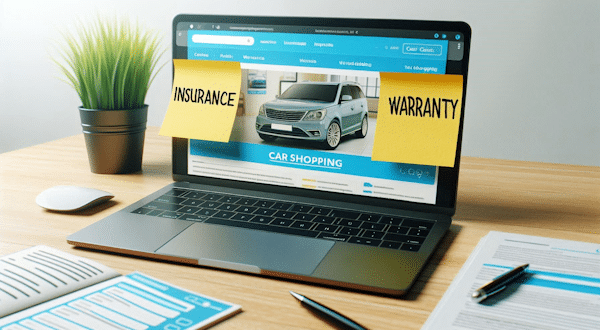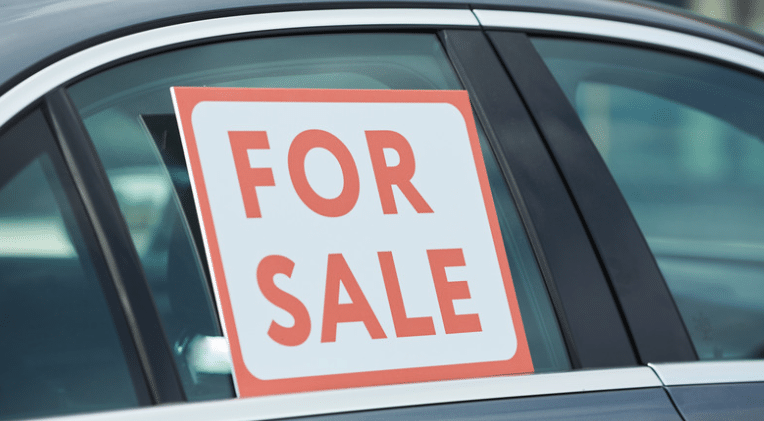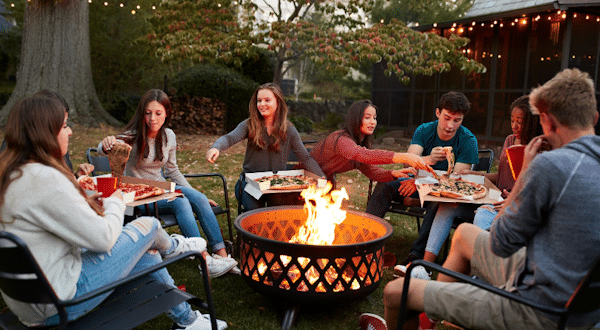
by California Casualty | Auto Insurance Info, Helpful Tips |
When it comes to protecting your vehicle, car insurance and vehicle warranties both play a big role. Knowing the difference between the two can help you make informed decisions about the coverage you need.
Vehicle Warranty
New car warranties
When you buy a new car, you get a factory warranty from the vehicle manufacturer at no additional cost to you. It is a guarantee that the car you bought is in good working order. A vehicle warranty covers replacements or repairs in case a component breaks or fails for a specified period. Typically, there is no deductible with a new car warranty. It covers both the new part and the labor.
A new car warranty generally comes in two parts:
- Bumper to bumper coverage: This covers repairs to most parts including electronics and air conditioning (for typically 3 years or 36,000 miles).
- Power train coverage: This covers the engine and transmission (for typically 5 years or 60,000 miles).
Sometimes a manufacturer’s warranty includes a limited corrosion warranty, emissions warranty, tire warranty, hybrid and electric car battery warranty, and roadside assistance. When your warranties expire, you often have the option to purchase an extended warranty.
Used car warranties
You can get warranties for used cars. A limited warranty comes with a certified pre-owned (CPO) vehicle. The cost is rolled into the higher price you will pay for a CPO vehicle. You also may purchase an extended warranty from your car’s manufacturer or a third party for most used cars. The cost of that extended warranty usually depends upon vehicle age, mileage, make and model, coverage level, your deductible, and the warranty provider.
What warranties cover and what they don’t
Warranties protect you against defects in your car’s parts from power windows and the infotainment system to your engine and transmission. They help cover repairs for those parts if they break or fail during the warranty period. Most car warranties are similar in their broad coverages but may differ in the details so check your policy for what is covered.
Warranties do not cover everything. They do not cover routine maintenance like oil changes or tire rotations. They do not cover wear-and-tear parts like brake pads or wiper blades. They do not cover damage from collisions, damage caused by the owner, severe weather, fire, or theft. For the latter, you need vehicle insurance.
Vehicle Insurance
Car insurance is required by law in most states for any car – new or used – that is on the road. This type of insurance pays for damage from a collision, or another covered adverse event such as fire or theft. Auto insurance does more than fix your car. It can help with medical bills for you, your passengers and the people you hit in a collision. It can help pay if the other driver is not insured. It even covers damages when another driver is at the wheel of your car and has an accident because insurance follows the car, not the driver.
What vehicle insurance covers and what it doesn’t
Car insurance policies are made up of different coverages. You choose the types you need from a range of options. Your premium is determined in part by the coverages that you choose.
- Liability: If you are at fault in an accident, and others are involved, it’s good to have liability coverage. Liability coverage is required by law in most states. It covers you for bodily injury and property damage you cause to others. However, it does not cover any damage to your own vehicle; that’s covered by collision. It also does not cover injury to you and your family; it only covers the people in the other car.
- Collision: This coverage is if your car is damaged in a collision with another car or an object, such as a fence. Your collision coverage will pay for repairs minus the deductible. Collision coverage is not required unless you’re leasing a car or paying off a loan on a vehicle. However, it may be good to have, especially in the event of an accident.
- Comprehensive: Comprehensive coverage is for natural disasters, fires, vandalism, theft and animals that damage your vehicle. Think of it as “bad luck coverage.” Comprehensive coverage is not usually required unless you’re leasing a vehicle or paying a car loan. However, it’s valuable to protect your car.
- Medical expenses: If you or others are hurt in an accident, you will want medical expenses covered. You will either be able to get medical payments coverage or personal injury protection (PIP). These coverages apply to everyone in your car whether or not you are at fault in the accident. This type of coverage is good to have, as your health insurance may not cover auto accidents and does not normally protect your passengers. PIP is only available in some states and may be mandatory if your state offers it.
- Uninsured or underinsured motorist: You may encounter drivers who are not insured or who are underinsured. If so, you will need insurance to cover your car and the people in your car if hit by an at-fault driver in that situation. Uninsured/Underinsured Motorist Property Damage (UMPD) helps pay for repairs to your vehicle. Uninsured/Underinsured Bodily Injury coverage pays for medical treatment, lost wages, pain and suffering for you and your passengers. These are optional coverages in most states. In some states, you are not allowed to carry collision and UMPD at the same time. Also, sometimes UMPD has a policy maximum, or cap on the amount it will pay.
Talk to your insurance agent to see what is covered under your policy. That way you’ll be fully prepared should anything happen. Safe travels.
This article is furnished by California Casualty, providing auto and home insurance to educators, law enforcement officers, firefighters, and nurses. Get a quote at 1.866.704.8614 or www.calcas.com.

by California Casualty | Helpful Tips |
You’re ready for a new car. That means you’ll have to decide what to do with your old one. Either you’ll want to sell your car or trade it at the dealer. Ultimately, the choice comes down to what matters most to you—getting top dollar for your vehicle or taking care of it quickly and easily. Here’s what you need to know.
Trading in Your Car
When you give your vehicle to a dealership in exchange for a credit toward a new car, that is a trade-in. Dealers take your used car and resell it, so that means you won’t get exactly what it’s worth. You’ll be offered a little less. Trade-ins work best with lower mileage cars. Cars over 100,000 miles cannot be re-sold by dealers as certified used cars.
Advantages
-
- Trade-ins are convenient and require minimum time and effort from you.
- Car dealers may be less picky about the car’s condition than an individual buyer.
- Dealers will handle all the necessary paperwork.
- You will have a credit to apply to a new car.
- You also might save on taxes. While some states tax buyers on the value of a new car, others tax you on the value, minus the trade-in.
Disadvantages
-
- You may not get as much money for a trade-in, as if you sold your car privately.
- If your car is old and has high mileage, the dealership may not want it or may offer a less-than satisfactory value.
Tips for Trading
-
- Don’t trade in a car for less money than you owe on it. You are still responsible for paying the lease in full.
- Having your original paperwork will make the trade-in process easier.
- Do your research and find your potential trade-in value.
- Check with multiple dealers to see if there is a difference in trade-in value.
- Don’t be afraid to walk away from the deal if you don’t get your price.
Selling Your Car
If you have the time, you can sell your car privately. You can generally get more money for a private sale, but it’s a lot more work. You will need to take photos of your vehicle, write an ad and post it, and then answer all the people who are interested. You also may need to negotiate for the price you want. Generally, selling independently works well if you have a car that’s high in demand, and if you are comfortable with the sales process.
Advantages
-
- You will probably get a better price than at the dealer.
- There are lots of online sites where you can post your car.
- If you sell your vehicle online, escrow services can help coordinate the sale while protecting both parties.
Disadvantages
-
- It takes a lot of time to sell a car. You may not be able to sell your old car before you buy your new car.
- It takes a lot of work to sell a car. You must create the ad and publicize the sale either online or locally with a sign on your car displayed in a prominent place.
- You will be responsible for any accidents that potential buyers cause in your car. That’s because insurance follows the car not the driver.
- You can put yourself in a risky situation with the exchange of funds. A bank check or direct wire might be best. You can also do the transaction in the parking lot of a police station.
- You must do the paperwork. This includes creating a bill of sale and making sure that the title is transferred correctly.
Tips for Selling
-
- Clean your car and remove bumper stickers.
- Take professional looking photos.
- Research the right asking price.
- Make any necessary repairs.
- Be honest in your ad.
- Advertise on safe sites.
- Potential buyers will want to do test drives. You will need to make sure they will not drive away with your car. Take a picture of the buyer’s driver’s license.
Beware of Car Selling Scams
- Car Sale Phishing: Scammers that pose as customers can steal your private information. In this scam, they ask for extra verification to get as much information about you as they can. They then use it to set up credit cards, access your bank accounts, or steal your identity.
- Confirmed Buyer: You may get a notification from an online site that you have a confirmed buyer. The email will request a finder’s fee before releasing the information. Usually they include a money-back guarantee, which is also fake. You end up being out the money.
- Fake Escrow: The buyer sets up a fake escrow account to hold funds until the vehicle is purchased. They will link to your bank account and steal your information and often, your money.
- PayPal Scam: The buyer will need your car quickly because of a transportation issue, and likely not haggle over price. They will say they can only pay via PayPal. They will send you an email from PayPal saying that the payment is awaiting approval to be released and ask you for a shipping fee. Once you send the payment, the buyer disappears and you’re out several thousand dollars.
- Payment Plan: The buyer will offer you a price above market value with a decent amount of interest to pay the car off over time. They’ll make the first payment and then you’ll never hear from them again.
Whether you sell or trade-in your vehicle, take precautions to do it safely. Your car is one of your greatest investments. Protect it with the right policy for added peace of mind.
This article is furnished by California Casualty, providing auto and home insurance to educators, law enforcement officers, firefighters, and nurses. Get a quote at 1.866.704.8614 or www.calcas.com.

by California Casualty | Auto Insurance Info, Helpful Tips |
It never feels good to fall victim to a scam or pay more for a product because of it. That’s what it is like with car insurance fraud.
Car insurance fraud happens when someone lies to get a better rate or a larger payout. It could be intentional or accidental, but either way it can cost you money in premiums. The FBI estimates that car insurance fraud costs the average family an additional $400 to $700 every year. In addition, nearly 7 in 10 consumers are tricked into illegal schemes, according to the Coalition Against Insurance Fraud. Here’s what you need to know about car insurance fraud, including some clever scams that could catch you unaware.
What are the types of fraud?
Staged Accidents
In staged accidents, dishonest people intentionally cause a collision with an unsuspecting driver. Then they misrepresent the situation, putting the other driver at fault—and thus get a payout that they don’t deserve. Common scenarios for staged accidents include:
-
-
-
-
- Two vehicles trap your car and force you into a rear end collision.
- Someone waves you on that it is safe to pull out, and then another car collides with you.
- You are tricked into turning early and the oncoming driver moves forward and collides with you.
- Another car purposefully sideswipes your vehicle in a dual left turn intersection.
- A car deliberately and abruptly brakes in front of you.
Injury Fraud
Dishonest people can file claims for unnecessary medical treatments or for treatments that they did not receive. Injury fraud also includes claims where people exaggerate the extent of their injury to get a bigger payout.
Exaggerated Claims
Sometimes after an accident, a dishonest person can cause additional damage to their vehicle to receive a bigger payout. That’s why taking photos of the damage is so important to do at the scene of the accident. Another exaggerated claim could be to file multiple claims for the same accident. Finally, disreputable shops can charge for repairs that weren’t made or for substandard work.
Counterfeit Airbags
If you have your airbag replaced by a dishonest shop, you might be charged for the original equipment manufacturer (OEM) bag but get a counterfeit one installed. In a worst-case scenario, a disreputable shop could install a garbage bag stuffed with rags. Counterfeit bags are dangerous and may not protect you in the event of an accident. The good news is that it’s easy to check. With an airbag, the light on your dashboard will flash when you start the car. You can also ask an authorized dealer to check that you have a quality airbag.
Windshield Replacement Scams
There are a variety of different scams associated with windshield replacement. Here are some of the most popular.
-
-
-
-
- A stranger approaches you in a parking lot and offers a free windshield replacement. They point out nonexistent damage that can be fixed. They take your insurance information and file an exaggerated or false claim.
- Windshield scam artists also could go door-to-door or call you with a “special” for customers in your area. Then they follow a similar process of filing a false claim.
- If you live in one of the states that has no deductible for windshield replacement, con artists can file a claim for your windshield and charge you for the deductible.
Tow Truck Scams
Tow trucks that appear right after your accident could be “bandits” who will only tow your vehicle to their shop and charge you hundreds to repair and release it. Calling your own tow truck will help you to avoid this scam.
False Reports of Stolen Vehicles
Reporting a vehicle that hasn’t really been stolen as stolen is illegal. So is misrepresenting the value of a stolen vehicle.
False Documentation
Intentionally providing a false address for your policy to get a better rate is a form of fraud. Understating the annual mileage, misrepresenting the use of a commercial vehicle, and failing to add a new driver also is fraud.
What are the consequences of fraud?
It depends on the seriousness of the fraud. For minor infractions, your claim can simply be denied. For more serious offenses, your policy may be canceled, you could be fined or even serve jail time. A misdemeanor for auto insurance fraud can come with a fine and probation. A felony conviction can result in significant fines and prison time.
How can you fight against fraud?
- Carefully check your insurance application forms for mistakes.
- If you’re in an accident, take good notes of all those involved. Take pictures at the scene. Don’t sign any documents or agree to any terms at the scene of the accident.
- Don’t accept fault for an accident if you believe you are not at fault.
- Be wary of individuals offering services that you didn’t request. Avoid sharing details about your auto policy with those who may be disreputable.
- Don’t tailgate. This gives criminals a chance to take advantage.
- If your car needs repairs or maintenance, go to a trusted professional.
- Don’t accept a windshield replacement offer.
- Choose OEM parts for vehicle repairs to avoid counterfeits. Before buying a used car, have a certified mechanic check that there are authentic air bags.
- Avoid rushed decisions. If someone is pressuring you into something, that could be a red flag.
If you suspect fraud, report it to your insurer as well as to the National Insurance Crime Bureau at 800-835-6422 https://www.nicb.org/.
This article is furnished by California Casualty, providing auto and home insurance to educators, law enforcement officers, firefighters, and nurses. Get a quote at 1.866.704.8614 or www.calcas.com.

by California Casualty | Helpful Tips, Safety |
It’s a beautiful night to sit around the fire pit. The flicker of the flames and the crackling of the fire create the perfect backdrop for relaxation and conversation. Yet the scene can quickly turn dangerous without the right precautions.
Each year, fire pits send thousands of people to the emergency room. Young children and pets are especially vulnerable. Fire pits can also pose a significant fire hazard for your property, igniting leaves and grass, wooden structures and even your home. Follow these 10 fire pit safety tips to help keep everyone and everything safe.
1. Choose the right location.
Place your fire pit at least 10 to 20 feet away from other structures. Keep it away from low hanging branches above. There should be a minimum of 12 feet between your fire pit and tree branches. Never set up below power lines or string lights, which can create immediate danger if sparks fly. Don’t put your fire pit under a building overhang or in an enclosed area. That could cause a buildup of smoke, carbon monoxide and harmful gases that can be deadly.
2. Select a safe, stable surface.
Avoid putting your fire pit directly on the grass or on a wood deck. Instead place your pit on brick, concrete pavers, gravel or sand. Alternatively, you can buy pit pads and heat shields for underneath your pit, as well as pedestals. Surround your pit with crushed stone, sand or brick for added protection.
3. Choose the right fuel.
Soft woods like pine burn less efficiently, and spark more. It’s better to buy seasoned hardwood kindling and logs. You also could use fallen branches from trees in your yard. Do not, however, use construction lumber like pressure treated wood, plywood or chemically treated pallets. These woods will emit toxic fumes when they burn. So will trash and plastic. Never start a fire with lighter fluid or gasoline; that will create a burst of flames and can even release toxic gas or cause an explosion. Don’t throw leaves into the fire. They are light and can be carried by the wind. Finally, when tending to the fire, make sure your sleeves are rolled up and your hair is tied back. Use heat-proof gloves, a metal fire poker or safe long handled tongs.
4. Check the wind conditions.
Don’t use your fire pit on windy days. Wind can easily blow sparks around to surrounding brush. Use a screen to contain sparks and large embers. If your fire pit is portable, place it in a location with a natural windbreak before you start the fire. Always heed “no burn” alerts from your local municipality. If they say conditions are unsafe for a fire, it’s too risky to chance it.
5. Keep chairs far enough away.
Carefully place your seats around the fire pit. If you’re too close, your hair or clothes could catch fire. Stay 3-4 feet away from wood burning fires and 2-3 feet away from gas fires. Keep children 3-10 feet away from the flames. If a light breeze is blowing, have guests sit upwind so they can keep clear of the smoke.
6. Supervise children and pets.
Children and pets don’t understand the dangers of fires. They are naturally curious. Teach children the rules about not touching the fire or fire pit and not throwing things into it. Make sure they stay sufficiently away and remind them if they venture closer. Consider barriers or designated areas for both children and pets. Make sure there is a responsible adult who always has eyes on them.
7. Drink responsibly.
Fire and alcohol are not a good combination. Alcohol is highly flammable, and overindulgence can affect our judgment, coordination, and reflexes. If you are going to serve alcohol around the fire pit, have a designated nondrinker overseeing the flames. Keep everyone a safe distance away. You also may consider a smokeless fire pit which could add a layer of safety.Never leave a fire unattended. Extinguish it completely when you are done.
8. Never leave a fire unattended. Extinguish it completely when you are done.
Sparks can fly and fire emergencies can happen in an instant. If you must leave the area, designate a deputy to watch over your fire pit. Remember that fires are “live” for long after they seem to stop burning. Almost extinguished fires with hot ash and hidden embers have been known to cause plenty of damage. Make sure to put out the fire completely before leaving it. Pour water over live embers. Turn the logs to make sure all sides have stopped burning. Check the fire pit the next day just in case. Hover your hand over the ashes to make sure they are not still radiating heat. When it is safe to do so, use a metal shovel to dispose of ashes in a metal pail or trash can. Then wet the ashes by slowing pouring water over them.
9. Be prepared to extinguish a fire in an emergency.
Always keep a shovel, dirt/sand, and water on hand in case of an emergency. You can smother the flames by piling dirt or sand on them. You can spray water from your garden hose but don’t use a focused stream which can spread embers. Also check your manual to see if your firepit is made from a material that is water safe and won’t rust or crack. You may want to invest in a fire blanket which can be used to smother a fire. A multipurpose fire extinguisher can be used as a last resort.
10. Check your local regulations.
Some municipalities require you to get a permit for your fire pit. Due to the fire risk, some homeowners’ associations (HOAs) don’t allow fire pits. Others require an onsite inspection from a local fire official. Do your homework and find out the local rules so that you can follow them.
Finally, protect your home with the right insurance. Accidents happen despite our best precautions. Make sure you have enough coverage in the event of a fire.
This article is furnished by California Casualty, providing auto and home insurance to educators, law enforcement officers, firefighters, and nurses. Get a quote at 1.866.704.8614 or www.calcas.com.

by California Casualty | Auto Insurance Info, Helpful Tips |
The moment you drive a new car off the lot, it begins to lose its value. This can come as quite a shock to new car owners. After all, you just spent your hard-earned money on a vehicle. Yet car depreciation is a reality. Understanding it will help anyone looking to buy, sell, or trade in a vehicle.
What exactly is car depreciation?
It’s the difference between the price you paid for your car and how much it is worth if you were to sell it.
How much do cars depreciate?
It depends a bit on the make and model of car. In general, cars lose 20% of their value in the first year, and 60% over the first five years, according to Kelley Blue Book. You can check out their 5-Year Cost to Own for details on different makes and models. You can also find a car calculator online to get an idea of depreciation for your specific vehicle.
What causes depreciation?
Most things that we buy lose value over time due to wear and tear. That’s the same with cars and trucks. Depreciation is caused by the age of the vehicle and the mileage for starters. In addition, as new models come out with redesigns and new technology, there is less demand for older vehicles. Finally, the condition of the car matters. If your car has been in an accident, or has lots of dents or rusting paint, that impacts the resell value.
Can you slow down depreciation?
While depreciation is inevitable, the good news is that you can take steps to help your car keep its value a little longer.
- Maintain your car. Since wear and tear can increase depreciation, taking care of your car helps it stay working its best. Follow the owner’s guide for recommended maintenance.
- Take care of your car’s appearance. Dents and scratches can reduce your vehicle’s value. Wash your car, repair scratches and dents, and keep it clean.
- Drive carefully. Accidents and damage – even when repaired – will impact a car’s value.
- Avoid custom modifications. While these can be fun, they may make it harder to sell your car down the line.
Here’s how to make depreciation work in your favor.
- Do you use your car for business? You can deduct your car’s depreciation on your taxes.
- Are you buying a car? You can purchase a one-year-old car that is as good as new, but you pay only about 80% of the price. Or you could choose a three-year-old vehicle where the bulk of the depreciation has occurred. Make sure to look for one with low mileage for the greatest value.
- Choose a make and model that will resell well. Some vehicles hold their value better than others. It depends on the brand’s reputation plus overall customer demand for certain models. Among the top resellers for 2024 are the Ford Bronco, the Toyota Tacoma, and the Mercedes Benz G-Class.
Other factors that will influence car depreciation include supply and demand. If there are supply chain disruptions that reduce inventory, used versions of those models could be valued at a higher rate. In addition, rising gas prices can put more fuel-efficient cars in demand. Keeping tabs on the market can help you to make informed decisions.
Insurance can also help with depreciation.
Since car loans can last five years, your new car could lose 50% of its value before you pay it off. The loan doesn’t go away even if your car is totaled or stolen. In the event of a total loss, insurance pays the current market value of your vehicle. That’s where a new car replacement policy or gap insurance could help.
New car replacement insurance gives you the money for a new vehicle of the same make and model, minus your deductible. This is typically an add-on coverage that is paired with either collision or comprehensive coverage.
Gap insurance stands for Guaranteed Asset Protection. It is also called loan/lease coverage. Gap is an optional coverage that is paired with either collision or comprehensive coverage. In a covered claim, collision or comprehensive help pay for the totaled or stolen vehicle up to its actual cash value. Gap covers the rest of the loan or lease.
Your car is one of your greatest investments. Keep it protected for added peace of mind.
This article is furnished by California Casualty, providing auto and home insurance to educators, law enforcement officers, firefighters, and nurses. Get a quote at 1.866.704.8614 or www.calcas.com.





